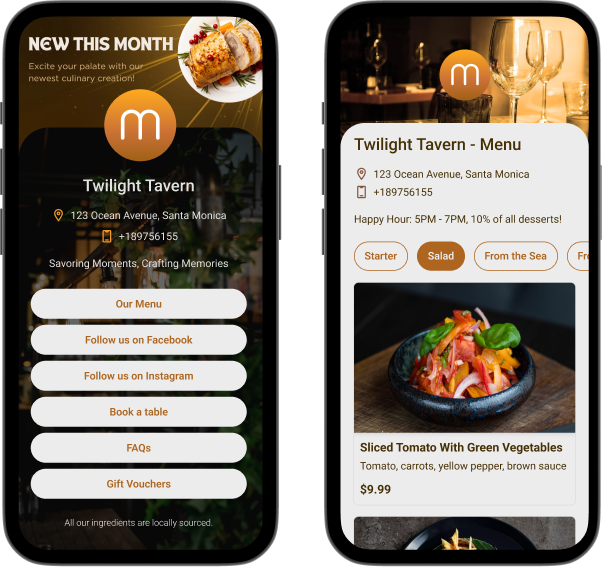
In today’s dynamic restaurant industry, effective menu planning plays a crucial role in determining a restaurant’s success. Whether you manage a high-end dining establishment or operate a casual eatery, thoughtful menu planning can streamline operations, enhance customer satisfaction, and maximize profitability. This comprehensive guide explores why menu planning is essential and how it can transform your restaurant’s efficiency and bottom line.
Menu planning is a systematic approach to designing and organizing your restaurant’s offerings to ensure efficiency, profitability, and customer satisfaction. It involves carefully selecting dishes, determining ingredient requirements, and structuring your menu categories to maximize appeal and operational effectiveness.
In the modern restaurant landscape, menu planning extends beyond traditional paper menus. With the rise of digital solutions, restaurants can now embrace dynamic menu planning that allows for rapid updates and enhanced customer engagement. For instance, digital menu platforms enable restaurants to efficiently manage their offerings, update prices instantly, and provide interactive experiences for guests.
The relationship between menu planning and restaurant profitability runs deeper than most operators realize. A well-planned menu serves as the foundation for sustainable financial success in the competitive restaurant industry.
At its core, effective menu planning begins with thorough cost control measures. Restaurant owners must carefully analyze ingredient costs, labor requirements, and overhead expenses to structure their menu effectively. Modern tools, such as a restaurant profit margin calculator, have made this process more precise than ever, enabling operators to make data-driven decisions about pricing and cost management. This systematic approach ensures that each dish not only delights customers but also contributes meaningfully to the bottom line.
Waste reduction represents another crucial aspect of how menu planning influences profitability. By implementing thoughtful portion control and carefully tracking ingredient usage across different dishes, restaurants can significantly minimize food waste. This becomes particularly important when dealing with seasonal produce and perishable ingredients. Efficient menu planning allows kitchens to optimize their inventory levels, reduce spoilage, and better predict ingredient needs throughout different seasons. The result is not just cost savings but also a more sustainable operation that appeals to environmentally conscious consumers.
Strategic menu design can significantly influence customer choices and spending patterns. By carefully positioning high-margin items, creating compelling menu descriptions, and structuring pricing tiers thoughtfully, restaurants can naturally guide guests toward more profitable selections.
The key lies in analyzing customer preferences and purchasing patterns over time, then adjusting menu offerings and placement accordingly. This data-driven approach to menu planning allows restaurants to feature seasonal specials, highlight signature dishes, and promote profitable items effectively while maintaining an excellent dining experience.
| Stakeholder | Benefits |
|---|---|
| Restaurant Owners | – Better cost control and profit margins
– Improved operational efficiency – Reduced food waste and inventory costs – Enhanced brand consistency |
| Customers | – Consistent food quality and taste
– Faster service with reduced wait times – Clear understanding of menu offerings – Better accommodation of dietary preferences |
| Staff | – Clearer workflow and responsibilities
– Reduced stress during peak hours – Better knowledge of dishes for recommendations – More efficient prep and service times |
| Chefs | – Streamlined kitchen operations
– Better inventory management – More efficient prep scheduling – Reduced food waste and spoilage |
| Suppliers | – More predictable order volumes
– Better inventory planning – Stronger long-term partnerships – Efficient delivery scheduling |
In today’s rapidly evolving restaurant industry, staff efficiency is paramount to success. A well-planned menu serves as a vital tool for training and organizing your team. When staff thoroughly understand the menu, they can prepare and serve dishes more efficiently, leading to smoother operations and better customer satisfaction.
Menu descriptions play a crucial role in staff training, helping servers inform guests about ingredients, preparation methods, and potential allergens. This knowledge enables waitstaff to make confident recommendations and handle customer inquiries professionally, reducing miscommunication and enhancing the dining experience.
Efficient menu planning directly impacts service speed and customer satisfaction. By carefully considering prep times and kitchen workflow, restaurants can significantly reduce wait times during peak hours. A streamlined menu allows chefs to prepare components in advance, ensuring quick assembly during service while maintaining quality.
The kitchen becomes more dynamic when working with a well-planned menu. Prep work can be scheduled efficiently, ingredients can be batch-prepared, and the workflow becomes more organized. This systematic approach helps overcome common challenges during busy periods and ensures consistent service speed.
The purpose of a menu extends beyond listing food items – it plays a role in creating memorable dining experiences. When planning a menu, restaurants aim to ensure that customers can find their favorite dishes consistently. Different dietary needs and restrictions are carefully considered during the menu planning process, allowing restaurants to cater to a wider audience.
Research shows that customers return to establishments where they know what to expect. A well-planned menu helps maintain consistent flavors across all dishes, and you’ll find that this predictability is key to building customer loyalty. Whether you’re running a restaurant chain or an independent eatery, planning ahead for seasonal changes and new recipe introductions helps maintain this consistency while keeping the menu fresh and exciting.
Effective meal planning is crucial for controlling food waste in restaurants. Before purchasing grocery items and ingredients, planning your meals helps determine exact quantities needed. This forethought in the menu planning process ensures that food items aren’t wasted due to overordering or improper storage.
Menu engineering principles help restaurants choose which items to keep, modify, or remove based on popularity and profitability. By analyzing competitor trends and customer preferences, restaurants can make informed decisions about new dishes to introduce while maintaining efficiency in ingredient usage.
Smart menu planning involves creating variety in your cuisine while maximizing ingredient availability. Restaurants can ease their operational burden by planning menus that share common ingredients across different recipes. For example, fresh herbs purchased for one signature dish can enhance multiple menu items, reducing waste and cost.
Types of menu planning vary by restaurant style, but the core principle remains: efficient use of ingredients across various dishes. This approach not only helps control costs but also ensures that all ingredients are used at their peak freshness.
With Menubly, you can create a free restaurant website with built-in online menu, and a hub for all your essential links like table reservations, social profiles, location, promotions, etc.

For restaurant chains especially, maintaining consistent food quality is paramount. The menu planning process must account for standardization across all locations, ensuring that customers receive the same experience whether they dine in New York or Los Angeles.
Menu components must be carefully documented beforehand, including detailed recipes and preparation methods. This documentation helps ensure that all cooks and kitchen staff can maintain quality standards regardless of location or experience level.
When planning your meals and organizing kitchen storage, menu planning helps restaurants maximize their available space. A well-thought-out menu considers ingredient availability and storage requirements beforehand, ensuring that you’ll have enough space for all necessary items without overcrowding.
Efficient storage planning plays a role in food safety and cost control. By carefully planning the menu, restaurants aren’t forced to store excess ingredients that may spoil before use. This systematic approach to storage management helps maintain fresh ingredients while reducing waste.
Kitchen operations become more efficient when staff has a clear understanding of the menu planning process. Cooks can prepare mise en place more effectively when they know exactly which food items will be needed for service. This preparation helps ease the pressure during peak dining hours.
The menu is one of the most important tools for kitchen organization. When planning a menu, consider how different dishes will be prepared during service. This forethought allows you to arrange cooking stations and prep areas logically, improving workflow and reducing confusion.
Research and planning ahead are crucial for making informed purchasing decisions. By analyzing competitor offerings and current trends in cuisine, restaurants can choose ingredients that balance cost with quality. The menu planning process should include careful consideration of:
Menu photography and design aren’t just about presenting food items – they’re essential components of your restaurant’s brand identity. When planning the menu, consider how each dish reflects your establishment’s unique character and target audience.
Different dietary options and trending dishes can help attract a broader customer base. However, it’s important to ensure that new dishes align with your brand’s core values and cuisine style. Your menu plays a role in telling your restaurant’s story and differentiating you from competitors.
Menu pricing becomes more strategic through careful planning. By analyzing food costs and competitor pricing, restaurants can set prices that maximize profitability while remaining competitive. The menu planning process should include regular review and adjustment of prices based on:
Restaurant menu planning directly influences staffing requirements. When planning your meals and service strategy, you’ll need to consider how many cooks and support staff are needed to prepare each dish efficiently. Different dietary options and complex recipes may require specialized staff, while simpler food items might need fewer hands in the kitchen.
Planning ahead for staffing needs helps restaurants:
The menu planning process plays a role in restaurant marketing strategy. When planning a menu, restaurants aim to create offerings that aren’t just profitable but also marketable. New dishes and seasonal changes provide opportunities for promotional campaigns that can attract customers and drive sales.
Research shows that competitor analysis and trend awareness are crucial for successful menu marketing. By staying informed about current cuisine trends and dietary preferences, restaurants can choose promotional items that resonate with their target audience.
Planning the menu with food safety in mind is essential. Restaurants must cater to various dietary restrictions while ensuring all food items meet health standards. This includes:
Modern restaurant operations have evolved beyond traditional paper menus and manual planning systems. Online menu solutions now offer restaurants powerful tools to streamline their operations and enhance customer experience. For instance, interactive online menus allow restaurants to update items and prices instantly, mark dishes as “out of stock,” and provide customers with detailed dish information and photos.
Some platforms, like Menubly, combine menu planning capabilities with practical features such as built-in online ordering systems. This integration helps restaurants reduce dependency on third-party delivery platforms while maintaining direct relationships with customers.
Menu planning plays a crucial role in restaurant success by controlling costs, reducing waste, and ensuring consistent quality. It helps restaurants cater to customer preferences while maintaining profitability.
Through careful planning ahead, restaurants can optimize ingredient usage, reduce waste, control labor costs, and maximize storage efficiency. The menu planning process also helps prevent overordering and spoilage.
Restaurant menu planning should focus on logical category organization, clear descriptions, and strategic item placement. Consider your cuisine type, customer preferences, and operational capabilities when structuring the menu.
Seasonal changes and market trends typically drive menu updates. While core items might remain consistent, restaurants should review their menu quarterly to assess performance and make necessary adjustments.
Common mistakes include ignoring ingredient availability, failing to consider kitchen capabilities, overlooking dietary restrictions, and not researching competitor offerings and trends.
Effective menu planning is fundamental to restaurant success. Whether you’re choosing new recipes, planning your meals, or analyzing food items, the process requires careful consideration of numerous factors. By following these guidelines and staying attuned to industry trends, restaurants can create menus that satisfy customers while maintaining profitability.
Remember that menu planning isn’t a one-time task but an ongoing process that requires regular review and adjustment. As customer preferences evolve and new trends emerge, your menu should adapt while maintaining the core elements that make your restaurant unique.
Turn your paper menu into an interactive online menu that your customers can browse and order from anywhere.